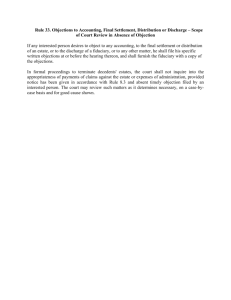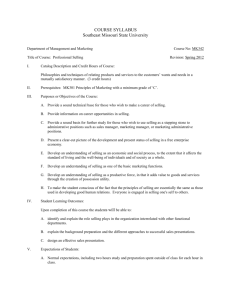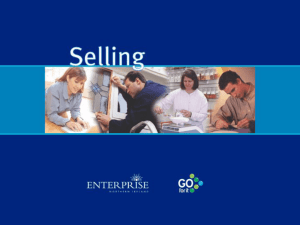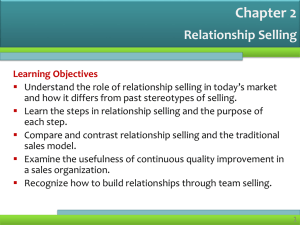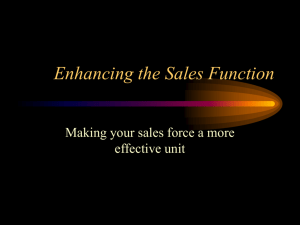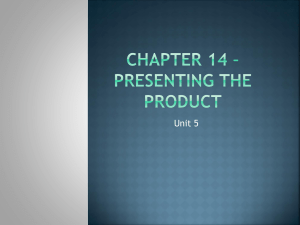MM 6622
advertisement
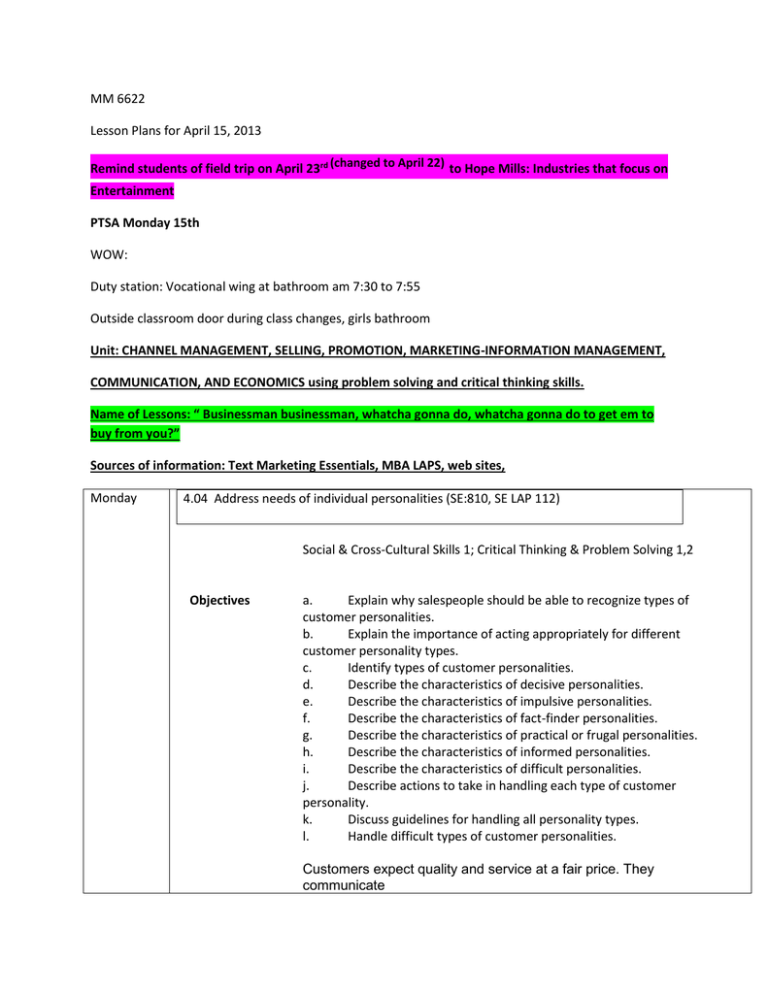
MM 6622 Lesson Plans for April 15, 2013 Remind students of field trip on April 23rd (changed to April 22) to Hope Mills: Industries that focus on Entertainment PTSA Monday 15th WOW: Duty station: Vocational wing at bathroom am 7:30 to 7:55 Outside classroom door during class changes, girls bathroom Unit: CHANNEL MANAGEMENT, SELLING, PROMOTION, MARKETING-INFORMATION MANAGEMENT, COMMUNICATION, AND ECONOMICS using problem solving and critical thinking skills. Name of Lessons: “ Businessman businessman, whatcha gonna do, whatcha gonna do to get em to buy from you?” Sources of information: Text Marketing Essentials, MBA LAPS, web sites, Monday 4.04 Address needs of individual personalities (SE:810, SE LAP 112) Social & Cross-Cultural Skills 1; Critical Thinking & Problem Solving 1,2 Objectives a. Explain why salespeople should be able to recognize types of customer personalities. b. Explain the importance of acting appropriately for different customer personality types. c. Identify types of customer personalities. d. Describe the characteristics of decisive personalities. e. Describe the characteristics of impulsive personalities. f. Describe the characteristics of fact-finder personalities. g. Describe the characteristics of practical or frugal personalities. h. Describe the characteristics of informed personalities. i. Describe the characteristics of difficult personalities. j. Describe actions to take in handling each type of customer personality. k. Discuss guidelines for handling all personality types. l. Handle difficult types of customer personalities. Customers expect quality and service at a fair price. They communicate their satisfaction to others, and this communication is multiplied further as it’s passed on to more and more people. If it’s positive, this “word-ofmouth” communication can be invaluable to both you and your business. If it’s negative, you may lose business. Specific buying decisions are influenced by a customer’s personality, the combination of his/her distinctive traits or qualities. Customers have unique personalities. Consider the following facts: Customers’ personalities contain combinations of good and bad traits. For example, a customer may be very pleasant and friendly, but he is also impatient and doesn’t want to listen to the instructions about how to set up his new stereo system. Keep in mind also that customers’ moods may change depending on the salesperson’s actions. A customer may be in a poor mood when first meeting a salesperson, but the salesperson’s friendliness and consideration may help lift his/her spirits. Fact finder. Customers who are fact finders are looking for information about products. As a salesperson, you are challenged to know your products inside and out so you can answer all their questions. Fact finders like to see variety and often comparison shop. For example, a fact finder might ask you to explain the differences between an iPod and a Zune digital media player. Practical or frugal. Practical or frugal customers are very cautious with their money and want the best possible value for every dollar they spend. They usually like the simple, uncluttered life and dislike experimenting with new products. A practical customer might ask, “Are you sure this muffler is guaranteed for the life of my car? I want to make sure I’m getting my money’s worth.” Informed. Informed customers have done their research on products beforehand and are confident about their choices before they even come in contact with salespeople. They spend for quality because they want the best. Informed customers are often trendsetters among their families, friends, and coworkers. Let’s say you work at the Audi dealership and today is the first day the new year’s models are in. A customer comes in ready to test drive and purchase one of the new cars. That is an informed customer! Difficult. Difficult customers can appear in many shapes and forms. They may be disagreeable, dishonest, domineering or superior, slow or methodical, or suspicious. Although most of the customers you deal with in your sales job won’t be difficult, the ones who are can sure cause a lot of headaches! Picture an angry customer demanding his/her money back or demanding to see your manager. You’ll definitely need to know how to address this customer’s individual needs. “This cell phone is a piece of junk. The display is dim, and the sound quality is bad. Are you going to give me my money back and a free new phone, or do I have to talk to your manager?” Students are to: a. Discuss the importance of feature-benefit selling. b. Describe product features that should be considered in preparing to use feature-benefit selling. c. Explain the importance of determining which features and benefits appeal to each customer. d. Explain the guidelines for prescribing a solution to customer needs. e. Demonstrate procedures for prescribing solutions to customer needs. Tuesday Teams must complete feature-benefit charts today AND explain target market for their product in their chart Why that target market? 4.04 Facilitate customer/client buying decisions (SE:811, SE LAP 108) Review: Define the terms buying motive, emotional motives, rational motives and patronage motives. b. Describe reasons that salespeople should understand customers' needs and wants. c. Identify reasons that customers buy. d. Classify buying motives as emotional, rational or patronage. e. Describe techniques for identifying buying motives. f. Demonstrate procedures for identifying customer buying motives for use in selling. Career level: Specialist Information 5-8; Interpersonal 11; Systems 15; Basic Skills 1-2,5-6; Thinking Skills 7,12; Personal Qualities 15 Social & Cross-Cultural Skills 1; Critical Thinking & Problem Solving 1,2 Lesson a. Define the following terms: buying decision, need decision, product decision, place decision, price decision and time decision. b. Identify types of buying decisions. c. Identify factors affecting place decisions. d. Cite factors affecting price decisions. e. List factors affecting time decisions. f. Explain the importance of salespeople's helping customers to make buying decisions. g. Describe guidelines to follow in order to facilitate customers’ buying decisions. h. Assist customer in reaching favorable buying decisions. Teaching from LAP 108 As you probably know from experience, buying decisions usually require a certain amount of assistance and reassurance from a salesperson. This applies not only to retail situations, but business-to-business sales as well. Successful salespeople are well prepared to help customers make all the small decisions that add up to the main purchase decision. Failing to assist customers at any point during the process can result in losing the sale and possibly even losing the customer. Customers and clients are unique. Each is at a different stage in the decisionmaking process when s/he talks to salespeople. There is no particular order in which they make the small buying decisions. In some cases, one or more of these decisions has already been finalized before even coming in contact with a salesperson. As a salesperson, you must therefore remain alert so that you can give each customer the assistance s/he needs to reach decisions throughout the sale—and to make the final decision to buy. When to offer a customer credit The availability and advantages of credit. When customers are unsure about the price decision, the availability of credit may persuade them to buy. Many stores offer deals such as 24-months’ credit with zero interest. However, it’s important that customers understand the pitfalls of credit. It would be unethical for a salesperson to convince a customer to buy on credit if the customer truly cannot afford the product at any price. As teacher leads, students are to take notes using a graphic organizer of their choice. Wednesday Review 4.04 Assessing customer needs (SE:113) [p. 5-104] 4.04 Demonstrating products (SE:893) [p. 5-106] 4.04 Prescribing solution to customer needs (SE:115) [p. 5-109] Lesson: a. Define the following terms: probing, information-gathering probes, opinion-gathering probes, and confirming probes. b. Distinguish between probing and questioning. c. Describe reasons for probing. d. Explain benefits of probing to assess customer/client needs. e. Identify probing techniques. f. Explain guidelines for assessing customer/client needs. g. Demonstrate procedures for assessing customer/client needs. With help of teacher, students will write sample probing questions. Guided: a. Define the following terms: sales talk and product demonstration. b. Explain the importance of an effective product demonstration. c. Describe guidelines to follow in selecting a product to demonstrate to a customer. d. Explain guidelines to use in demonstrating products. Students are to: e. Demonstrate a product. Teaching from LAP SE 103 (notes) LAP-SE-103-SP © 2012, MBA Research and Curriculum Center® Show and Tell When it comes to convincing customers of their need for products, “seeing is believing” is a good rule to follow. In most cases, customers xxxxxn told that you need to chill out? Ever been asked, “What is your prool. Describe an effective product demonstration. Demonstrate product. Let Me See. . .prefer to see exactly how a product operates rather than simply trying to imagine it. Fortunately, nearly every item has at least one feature you can actively demonstrate to customers. All of us have experience as customers—and it’s experience you can draw upon as a salesperson. What was it about an effective sales presentation that convinced you to buy a particular product? What occurred in a poor presentation to make you walk away empty-handed? Introduction: B 1. Handle the product with respect. 2. Creatively display product features. Emphasize the product features that interest the customer by creatively displaying each one. Single out each feature by displaying only one at a time. Hold the product so that the customer’s attention is focused directly on it. If the product is too large to hold, gradually position customers so that they can focus their attention exclusively on the product. 3. Question the customer to learn about her/his needs for the product. During the product demonstration, you should continue to question the customer, asking his/her opinion of the product features and benefits. Answers to these questions will provide feedback that will help you determine if you are demonstrating the right product features. Alice makes sure to ask her customer questions during the product demonstration. As she demonstrates a product feature, she asks questions such as: • “Do you think the compartments in this luggage will help keep your overnight business trips more organized?” • “How do you like the light touch of this keyboard? Isn’t it easy to type on?” • “What do you think of the automatic focus feature on this camera?” 4. Use dramatic actions to show the product in use. Always use common sense and good taste when demonstrating a product in an unusual way. Do not demonstrate a product in an unusual way simply for sensationalism or special effects. Only do such a demonstration to prove that the claims you are making about the product features are true. Unusual demonstrations will not impress every customer. In fact, some customers will be turned off by such demonstrations, seeing them as “cheap” or insincere. So, be sure to evaluate your customers to determine if you think this type of demonstration will positively impress them. When you use dramatic actions to demonstrate a product, be honest. A deceptive product demonstration distracts from the product’s image. Only an honest demonstration will produce a satisfied customer. 5. Involve the customer’s senses. When showing a product in use, why not let customers operate it for themselves? You know how to display the product in an attractive manner—now, be sure to get the customer involved in the demonstration by not only seeing the product, but by touching, hearing, tasting, or smelling it. Through this type of customer involvement, customers can experience for themselves the real features and benefits of the product you are demonstrating. Slip the jacket on the customer so that s/he can feel the softness and quality of the fabric. Print a color copy so the customer can see the sharp, rich colors the printer can produce. Turn on the speaker system so the customer can hear how clear the music sounds. 6. Use a descriptive, accurate vocabulary. “This soft fabric is cool and comfortable to wear” is a descriptive phrase that emphasizes the product’s positive features. 7. Show enthusiasm for the product. Relay your enthusiasm for the product to the customer through your words and actions. If you are excited about the features of the product, this excitement is likely to transfer to the customer. Be sure to show your enthusiasm in your voice level and voice tone. Facial and body gestures also communicate enthusiasm. Use your hands, arms, and expressions to demonstrate your interest in the product. Establish and maintain good eye contact with the customer. Good eye contact communicates confidence in yourself and in your product. 8. Anticipate interruptions. No matter how carefully you prepare your product demonstration, you can expect some interruptions. Not everything will go exactly as planned. The customer’s tired, anxious children may interrupt the demonstration. You may be called away for a telephone call or to assist another employee. Or, perhaps the customer will be in a hurry and try to rush you through your demonstration. All these interruptions could confuse your rehearsed demonstration techniques.So, expect to have some interruptions. Don’t be flustered or lose control of the selling situation. 9. Effectively use selling aids. 10. Practice the demonstration. SUMMARY Effective sales presentations have two parts, the sales dialogue and the product demonstration. A successful product demonstration ignites customer interest and creates the desire to buy. To choose the right product to demonstrate, determine product use, show popular products, consider the customer’s price range, and limit choices. Choose product features to highlight, and create a product analysis sheet to organize your thoughts. Above all, keep the customer’s individual needs and interests in mind. Thursday Performance Indicator Convert customer/client objections into selling points (SE:874, SE LAP 100) Level Specialist SCANS Information 5-7; Interpersonal 11; Systems 15; Basic Skills 1-2,5-6; Thinking Skills 7,12; Personal Qualities 15 21st Century Skills Creativity & Innovation 1,2,3; Communication & Collaboration 1; Critical Thinking & Problem Solving 1,2,4; Social & Cross-Cultural Skills 1 Lesson Objectives a. Define the following terms: objection, yes, but. . ., toss-it-back, deny it, point-counterpoint, inquiry, show 'em, testimonial, try it. b. Distinguish between objections and excuses. c. Explain the importance of properly converting customer objections into selling points. d. Describe reasons that salespeople should be prepared to answer objections. e. Classify types of objections. f. Describe methods of converting objections into selling points. g. Explain procedures for converting objections into selling points. h. Demonstrate skill in converting objections into selling points. Intro and summary to lesson from LAP SE 100 There are six general steps that salespeople can follow when converting objections into selling points—listen carefully; pause before answering; empathize with customers, restating their objections; avoid arguments; convert objections into selling points; and, answer objections honestly and continue selling. An objection is a point of difference between a customer and a salesperson that may prevent a sale. It is the customer’s reason for not buying. Sometimes, objections are merely questions or concerns that you can help to resolve. It’s your responsibility to help the customer determine if the objections are serious enough to prevent the sale. The fact that customers raise objections indicates that they are interested in the product you are selling. Truly uninterested customers seldom bother to raise questions or objections. They simply say, “No, thank you,” and move on. Therefore, objections frequently signal customer interest. To be successful in sales, you must know how to effectively convert objections into selling points. Objections v. excuses An objection is a sincere, valid reason for not buying. On the other hand, an excuse is an insincere statement used to cover up a real reason not to buy. A common excuse customers use when they don’t want to listen to sales presentations is, “I’m not ready to buy,” or, “I’m just looking.” How many times have you heard customers make those statements, or even made them yourself? Excuses used as cover-ups are often difficult to handle because they hide the real objection. Since customers may be embarrassed by their hidden objections, they avoid discussing them. You will have little success selling your products unless you are able to uncover the real objection. Finding the real objection The best way to find the real objection is to get the customer talking. When you ask open-ended questions pertaining to the product(s), the customer will need to provide more than a “yes” or “no” answer. Then, by carefully listening to the customer’s answers, the real objection may surface. Students are to: . Briefly describe each of the following common customer objections: a. Cost d. Timing b. Product e. NeedNeed A common objection occurs when there is a conflict between a want and a need. A customer who is interested in a video gaming system might say, “I would love to have this system, but I don’t know if I really need one.” Even though customers want an item, they will not buy it unless they are convinced that they have a real need for it. Your job is to try to establish that need by stressing the benefits of the product and the value it offers. Also, customers may experience a conflict of needs. A customer who is looking at a van might say, “Yes, the company needs a new van, but we need a large delivery truck more.” In this case, the need for the truck will dominate, and it will be difficult to sell the van. Since your primary goal in selling is to satisfy your customer, you should try to find a suitable delivery truck for the customer. Remember, if you are able to satisfy the customer’s needs this time, s/he may very well return to buy the van at a later date. c. Company A customer who is looking at a van might say, “Yes, the company needs a new van, but we need a large delivery truck more.” Handle the concern by converting objections into selling points. Friday Close the sale (SE:895, SE LAP 107) Specialist Information 5-8; Interpersonal 11; Systems 15; Basic Skills 1-2,5-6; Thinking Skills 7,12; Personal Qualities 15 Creativity & Innovation 3; Communication & Collaboration 1,3; Critical Thinking & Problem Solving 1,2; Social & Cross-Cultural Skills 1; Flexibility & Adaptability 1 a. b. c. d. e. Define the term sales close. List reasons that closing a sale is a courtesy to customers. Explain the importance of using an appropriate closing technique. Identify closing techniques. Describe the following closing techniques: direct, assumption, minor-points, summary, standing room only, closing on objection, contingent, contrasting advantages and disadvantages, suggesting ownership, narrative, related merchandise, bonus, and silence. f. Classify examples of closing techniques. g. Describe guidelines for closing sales. h. Demonstrate how to close a sale. Teach using these notes: The close is the point in a sales presentation at which the salesperson gains the desired agreement from the customer. It may come at any point during the time that you are with a customer. Closing sales benefits both customers and salespeople. Common methods of closing sales include: direct close; choice close; assumption close; minor-points close; summary close; standing-room-only close; closing on objection; contingent close; contrasting advantages and disadvantages close; suggesting ownership close; narrative close; related product close; bonus close; and silence close. Tips for closing Regardless of closing technique, product, or customer type, salespeople should observe the following general guidelines when closing sales. Be alert. Keep in mind that the close really begins when the salesperson starts the sales presentation. From the first contact with the customer, the salesperson is trying to close. This is what people are referring to when they talk about the “ABCs” of selling—always be closing. The best time to close the sale may come at any time during the presentation, so you must always be alert for these opportunities. Remember that you are approaching customers who are at different points in their decision-making process. The best time to try for a close is when the individual customer seems receptive to making a favorable buying decision. Sometimes a customer has made a buying decision before talking with a salesperson. Other customers may require several visits before they decide. Regardless, you must be ready to close whenever the customer is ready to buy.


